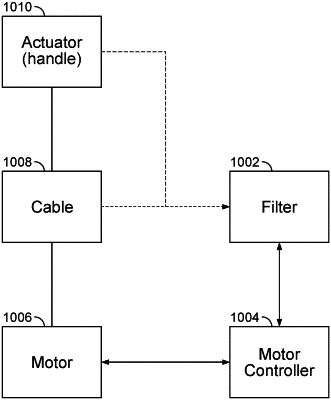| CPC A63B 21/0059 (2015.10) [A63B 21/00181 (2013.01); A63B 21/015 (2013.01); A63B 21/018 (2013.01); A63B 21/16 (2013.01); A63B 21/169 (2015.10); A63B 21/4035 (2015.10); A63B 23/1281 (2013.01); A63B 24/0062 (2013.01); A63B 24/0087 (2013.01); A63B 71/0054 (2013.01); G01L 5/04 (2013.01); G01L 5/107 (2013.01); A63B 2071/0072 (2013.01); A63B 2220/17 (2013.01); A63B 2220/34 (2013.01); A63B 2220/40 (2013.01); A63B 2220/62 (2013.01); A63B 2220/80 (2013.01); A63B 2220/805 (2013.01); A63B 2220/833 (2013.01); B66F 19/00 (2013.01); G01L 1/04 (2013.01); G01L 1/22 (2013.01); H02P 3/00 (2013.01); H02P 2203/00 (2013.01); H02P 2203/03 (2013.01)] | 20 Claims |

|
1. An exercise machine, including:
an actuator;
a motor;
a cable coupled between the actuator and the motor; and
a processor configured to:
make a first determination that a range of motion of a user of the exercise machine is between pre-determined motion thresholds;
while the range of motion of the user is between the pre-determined motion thresholds, determine a velocity of the cable being below a pre-determined velocity threshold; and
in response to a determination that the velocity of the cable being below the pre-determined velocity threshold while the range of motion of the user is between the pre-determined motion thresholds, make a second determination that the user should be spotted, wherein torque of the motor is reduced based at least in part on the second determination that the user should be spotted, wherein the actuator is wirelessly connected to the processor.
|